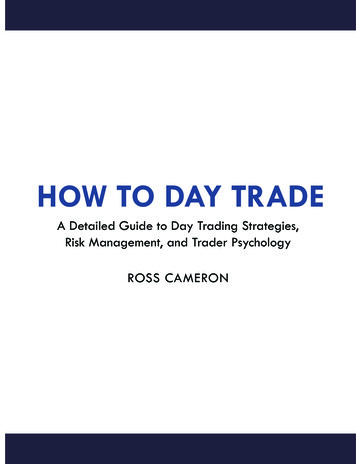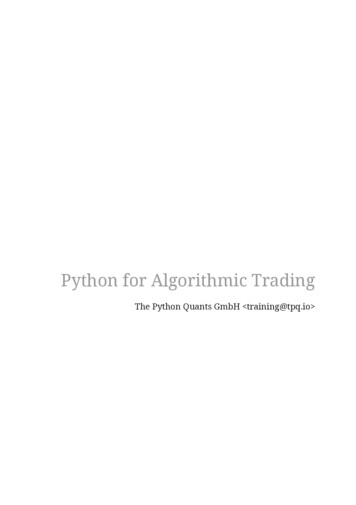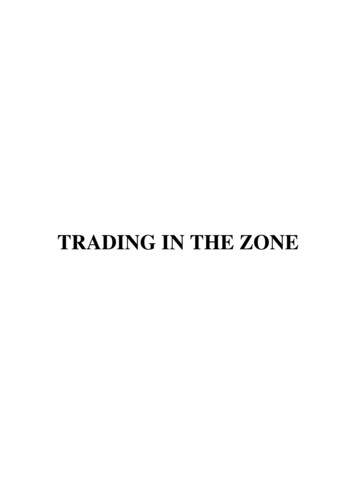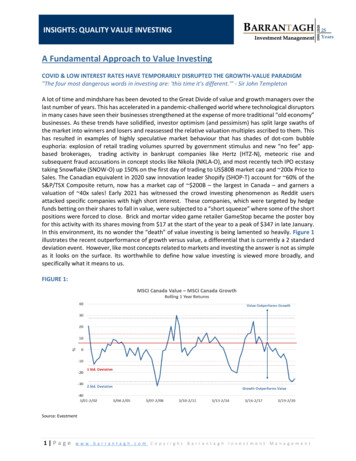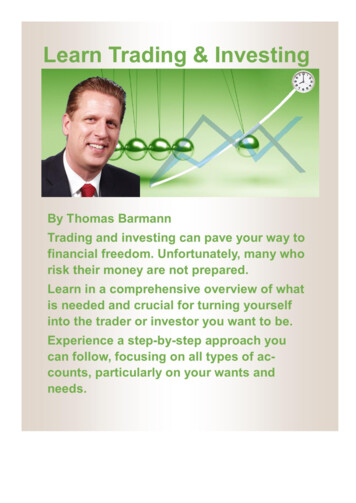
Transcription
Table of Contents1.Introduction . 12.Risk Limiting Strategies . 43.System Probability . 104.Number of Opportunities . 145.Available Budget and Time . 176.Mindset . 19About the AuthorThomas Barmann s introduction to trading came when he was 22. Over the decades, heacquired a wealth of knowledge, how private investors can make money in the financialmarkets. He developed algorithms and software for high probability trading and investingwith specifically defined trade situations, entries, exits, and stops.He trades by taking advantage of spotting and trading along with institutional money moves,minimizing risk, and compounding interest. The crowd follows the leaders. As a privateinvestor, you can do that too. Your edge is that you are faster in and out of investment thaninstitutions can do.A very small group of people keeps the knowledge of how to trade the financial markets andthose who enter unprepared pass their money to those who know. He aims to make theworld a better place by sharing knowledge and giving education. To do so, he formed aneducation company in 2008. The mentorship programs of Nobel Living, LLC are taught oneon-one at your best available days and times.For more information, please check:Blog Posts: WordPress-, Blogspot with a daily warmup at https://t.me/neverlosstradingJoin our Facebook Community: https://www.facebook.com/TradeWhatYouSeeThomas is the author of three published books and many other publications: Integrated Trading and Investing SystemMy Stock Market IncomeYour Trading Career as a Private InvestorExperience a Live Interview at 52 Trades:https://www.youtube.com/watch?reload 9&v bloe89B5ZOYCall: 1 866 455 4520 or contact@NeverLossTrading.comGood trading,Thomas Barmann
1. IntroductionWelcome to financial markets: an exciting world ofopportunities.You cannot save your way to financial freedom;however, trading and investing can pave the way to it.To get there, treat trading as a business (structure,focus, repetition, plan). Trading has a simple business setup: computer andplatform Time to market is short It can be conducted fulltime, parttime, or in additionto other activities; from the comfort of your home orat any place in the world with internet access There is no need to convince clients or competewith others for the same idea Education and training are readily availablewww.NeverLossTrading.com1
The financial markets are “the” equal opportunityworkplace in the world: age, race, gender, religion, preeducation, political beliefs, civil status do not matter ormake a difference.Here is what makes a difference:CriteriaCapital and itspreservationNeedRisk limiting strategiesTested high probabilityof the concept you goto market withThe productivity of thesystematic you apply65% or higher likelihoodwith mechanical rulesAvailable time andeducation budgetYour mindsetA high number ofopportunities to producemultiple streams of incomeon numerous time framesGive yourself 3-6 monthsto learn and practice for atleast two hours per dayBe open-minded to learnor forget and re-learn whatworks and what does notRealityNo odds appraisal andunbalanced riskacceptance: gamblingLow probability with broadroom for interpretationSingular focus andovertradingQuick follower schemeswith low or no investment: 297 to financial freedomFixed thinking with no orlittle room for learningIf trading was easy, nobody would ever go to work! But itis learnable.Price is not a variable; it is the result of the transactionsbetween supply and demand. Over time, underlyingsupply and demand changes can be measured,extrapolated, and build a decision-making base for longor short trading/investing strategies.Institutional transactions dominate financial markets,and the crowd follows the leaders.Those markets are readily available for you too. Youredge: You can be faster in and out of investments bywww.NeverLossTrading.com2
being able to open and close entire positions at once,while institutions need to scale in and out.Here is how a typical supply/demand pattern withleaders and followers looks like:NeverLossTrading Price Following Concept (long)Careful: Where most systems fall short is assuming aharmonic price pattern; however, price developmentevolves erratically and needs a detector based on theprice action of now instead of the past.A very small group of people keeps the knowledge ofhow to trade the financial markets and those who enterunprepared pass their money to those who know.To share knowledge and give education, I formed aneducation company in 2008. The mentorship programsof Nobel Living, LLC focus on one-on-one teaching andwww.NeverLossTrading.com3
coaching at your specific wants and needs and bestavailable days and times.Let us now come to the critical variables of tradingsuccess and how you can influence them:2. Risk Limiting StrategiesThere are multiple strategies for limiting the risk oftrading, and they depend on the length of time you wantto stay in a trade or an investment.The difference between a trader and an investor is onlythe holding time of a position; the decision-makingprocess is the same.NeverLossTrading is not a promise to not lose a trade; itis a concept to repair trades instead of taking the stoploss: Never Stop Loss Trading was a bit lengthy.Where is the money?www.NeverLossTrading.com4
Many of us hold investing accounts in multiple forms: IRA 401(k) Cash Accounts Margin AccountsTrading is usually associated with holding positionsshort-term based on margin accounts; however, theaverage trader or investor keeps much higher holdingsin their IRAs or 401(k) accounts. Hence, we highlyrecommend operating with risk-limiting strategies for allyour accounts and share this in our mentorships.Day Trading and operating with a stop loss is a reliabletactic to limit your trading risk.The first struggle day traders face is trading for too smallprice moves.Aside from commission, there is a bid/ask spread toconsider in your trading, and if you trade for smallincrements, the odds for making money will stack upagainst you.The table's left side shows the expected result whentrading for 50 price moves and the right side for 200.Value Change /ES 50ShareValue Change /ES 200Risk 50.0Risk 200.0Bid/Ask Spread 12.5Bid/Ask Spread 12.5Commission 4.0Commission 4.0Slippage Commission 16.5Slippage Commission 16.5PNL 50Wining 33.5Losing 66.555%- 11.5065%- 1.50www.NeverLossTrading.com33.0%PNLShare8.3% 200Wining 183.5Losing 216.555%- 18.1565% 152.525
The table shows that traders, aiming for a 50 pricemove, representing a price change of one point of the/ES (E-Mini S&P 500 futures contract), regardless ofoperating with a 55% or 65% system, will not makemoney long-term. When aiming for a 200 price change,traders with a 65% system aim for a solid return; thosewith a 55% system are still losing money.We can already spell two critical success factors:A) When trading Futures or FOREX, trade for aminimum value change of 200 to keepcommission and slippage below 10% of the pricechange you trade for. When day trading stocks,focus on price moves 0.5% of the share valueand trade for a price change 99 cents.B) Operate with a system that gives you a 65% orhigher probability of winning. With a lowerprobability system, success will be random.Trading is a numbers game, and those who understandthe critical actions are up for making money. Those whoare not willing to change give to those who know.By our human nature, if we once commit to a particularbehavior or systematic, we like to hold on to it (check onthe term: cognitive dissonances). Behavior-change ishard for us. Some of our long-term traders joke that itneeds somebody to take the other side of our trades;however, we preferably want an institution to render themoney to you by following better principles.www.NeverLossTrading.com6
But how do you solve this?Let your system tell you the price-speed for everyinstrument and time frame you choose, and thencompare if it is above or below the shared 200threshold.To get to the price speed, let us share some of thefundamental principles:When you move to swing trading or longer-terminvestments, you can be exposed to gaps, and thosecan produce drawdowns that are not easy to recoverfrom:- Swing Trading: holding positions for multiple days- Long-Term Investing: holding positions for weeksor monthsWhat to do to limit the risk of trading?You have three choices:Trade Instruments that Rarely GapFutures are those types of instruments.Futures contracts allow an investor to speculate on thedirection of a security, commodity, or financialinstrument, either long or short, using leverage: You only need to bring up 2% to 10% of the value ofthe underlying contract. Futures trade from Sunday 6 p.m. EST to Friday4:15 p.m. ET.www.NeverLossTrading.com7
Uptick rules and SEC regulations that limit shortselling opportunities in stocks are not active forfutures trading. Most futures cash settle, or your broker settles themfor you to prevent physical delivery of the underlyingcontract base. While as a meaningful investor, youdo not hold positions through contract change (astraightforward rule to put into your trading plan). To Limit the gap risk, decide from a weekly chartNLT /ES Weekly ChartOn the chart, we highlighted six critical trade situationsand want to explain those in the following table:www.NeverLossTrading.com8
Entry RuleSignalTrade Target and StopResult base on onecontractSituation-1NLT OrangeSignal for earlyprice changeindicationTarget: 2-SPU Increments(200 points), max. 10Candles.Stop: 20% of 1-SPU belowthe low of the candle.The NLT Purple Zonesignifies a pricedevelopment stage ofambiguity. The direction isnot found, and when thisstage ends, we assume adirectional price move for 1SPU might happen.Sellers are taking commandover buyers, and we tradefor a 2-SPU price move tothe downside.Favorable Reward/Risksetup.Same procedure as inSituation-1.Reliable trades to the 2SPU targetsNLT Purple Zone, and suchan environment with highervolatility and risk.No Trade because of thehigher expected risk.Buy 2,491,3Situation-2Purple NLTSignalBuy 3,065Situation-3Red NLTPower TowerSell 3,562.1 with CiC(change incommand)Situation-4/5The OrangeNLT SignalBuy Signalsidentifies priceturning pointson the lowSituation-6Buy SignalNLT PowerTower buysignalTarget reached.The price moveconcluded at target.If you wanted to trailstops, you do it with thered line on the chart.The rapid developmentto the downsideproduced windfall profits.On this chart, the average risk to accept is 145-/ESPoints or 7,250.For longer-term investing accounts, a 5% risk toleranceshould build a factual basis and such; you need to hold 145,000 in your account to trade the E-Mini S&P 500futures contract from a weekly chart.If this is outside your risk perspective, scale down to the/MES (Micro S&P 500 futures contract), which is in a10% relation to the E-Mini contract and such, yourwww.NeverLossTrading.com9
account holding minimums for trading this contract shallbe 14,500 or multiple increments of this.If you are swing trading futures, you are exposed to amuch higher gap risk; however, gaps might also run inyour favor. If you are not willing to take such a risk, youmight want to change instruments and strategies totrade:- Stocks, combined with options- Long Put or Call optionsThere are multiple rules involved in accepting the tradeor not, and this is precisely what you expect from yoursystem: Mechanical setups to follow through with no orvery little room for interpretation.We also apply the same principles to stocks and optionstrading at multiple time frames. Explaining all details isimpossible in this document's structure; however, we dothis in the numerous hours of working together in ourmentorship programs.3. System ProbabilityMost traders work with a low probability system, and suchmaking money is random. Let us demonstrate this in a simpleexample, where we draw from a bag of marbles and put themback after the draw, and we calculate the likelihood of winningsix or more times with a 55% system (11 winners out of 20) anda 65% system (13 winners out of 20).www.NeverLossTrading.com10
65% System55% SystemTo calculate the excepted results after ten draws for winning sixor more times, we use the so-called Bernoulli calculator for theprobability of each outcome.Replicating System Performance by Drawing MarblesYou see, your rate of expectingmore winners than losers with a55% system is random: 50.4%.When using a 65% system, youhave a 75% chance to cash-inmore winners than losers.Make sure you are not using standard indicators andsetup. Check for 100 happenings on mechanical rules ifthe system performance is at or above 65%.Unfortunately, mechanical rules are not commonpractice, and most traders guess entry, exit, and stop.It is critical for defining mechanical rules, consideringstatistical volatility or one price unit's speed, which wecall SPU (Speed Unit).Through this measure, you will determine if you areaccepting the risk of a trade or not.www.NeverLossTrading.com11
Successful traders do not trade to trade; they tradewhen their system conditions are met.Trading requires probability thinking to bend the odds inyour favor, and we want to share the basis of operatingwith the right mindset and tools.When you trade, you have multiple challenges tomanage:- Probability of the Setup- Risk/Reward Relation- Rules (entry, exit, stop)We could add more, but we want to focus on the mostcritical factors and explain:Probability of SetupsDo you know the probability of the setup you are acting on?If you are using standard indicators or your likelihood ofestimating the future price direction is between 51% and 55%.Still, such systems have a slightly positive expectation, so whyare about 75% of the retail traders losing money?They stay too long in the trade and such exit whenprices are already starting to retrace or revert, and such,they cut the winners short and get banked by losinghigher amounts than they are winning.Besides, novice traders guess entries, exits, and stops:Leaving things up for interpretation instead of tradingwith system-defined mechanical rules and strategies.www.NeverLossTrading.com12
When leaving mechanical rules aside and operating witha high probability trading system 65%, you still haveno guaranty for making money.Trade results are in a relationship of risk and reward.Two easy definitions upfront: Reward Abs(Entry – Target) Risk Abs (Entry – Stop)When we combine Risk/Reward with system probabilityand the probability of such relations to occur for a 200price move, we come to the following overview:Risk 350300280260240200180160100Reward 200200200200200200200200200Rik to 0.8:10.5:165%65%65%65%65%65%65%65%65%Return 82532394660677495Returnon Risk2%8%11%15%19%30%37%46%95%Occurrence Share of Stocks, Stocks, AnnualTrade to Cash, 3% Return, Cash, 3%TakeReturn Return, 5 Days,200 4.2%You see, even when trading with a high probability,about 40% of the setups are not suitable for risking yourmoney: because they require you to accept too high riskconcerning the reward of your trade. You need to sortout those trade setups that are not suitable and neveraccept a risk higher than 1.2:1 (mainly when we areincluding commission).www.NeverLossTrading.com13
Calculations for a 55% system shows the following:Risk 350300280260240200180160100Reward 200200200200200200200200200Rik to 0.8:10.5:155%55%55%55%55%55%55%55%55%Return- - - - Return Occurren Share of Stocks,on RiskceTrade to Cash, 06%0.11%0.19%0.73%Stocks, ParticipatAnnual ion RateReturn,Cash, 3%Return, 5Days, 200Days1.3%-0.3%-0.4%-0.3%0.1%2.4%4.5%40 of 1007.7%29.3%Only four out of ten trades are acceptable, andunfortunately, many traders have the urge to trade thetrade, risking too much and by this are part of the 75%losing investors.Comparing the 65% system to the 55% system showsthat the higher probability system allows for a 50%higher participation rate. Let us calculate a shortproductivity comparison of the two systems at two tradesper day at a 200 price move.SystemProbability2 Tradesper DayRate ofParticipationAnnualTrades(200 days)65%55% 400.00 400.0060%40%240160Duration:5 Daysper Trade4832ProductivityDifference50%We will further detail what trading productivity means toin the next paragraph.www.NeverLossTrading.com14
4. Number of OpportunitiesA reliable system produces signals on multiple timeframes, allowing you to generate multiple incomestreams from trading and investing.On a bag of marbles experiment, the number ofopportunities you participate in will determine theoutcome. In trading or investing, things get a little morecomplicated:The instrument and time frame you trade determines thepotential risk and return of your decisions.We generally favor percentage-based position-sizingmodels. The trading instruments you choose define thenumber of holdings needed in your portfolio ofinvestments to reach an 80% engagement rate orinvestment rate.Why not 100% engagement?If things go wrong, leave 20% capital for potential traderepairs. Let us puzzle together an example:-Capital: 50,000Maximum of 3% risk per trade: 1,500All calculations assume the same risk as rewardWe differentiate six trading styleso Day trading stockso Swing trading stockso Longer-term investing in stockso Swing trading optionso Longer-term investing with optionso Day trading futures on the example of the /ESwww.NeverLossTrading.com15
Position Holdings for Different Trading StylesTrading StrategyReturn to InvestmentTrade for per Trade at80%Positions at80%EngagementAvg. Days inthe TradeTrades ExpectedperMonthlyMonth Return at65%winning206.0%42.4%23.0%Day Trading StocksSwing Trading StocksLonger-Term Investing1%2%5% 40,00040,00020,0001121520Swing Trading OptionsLong-Term Options Trading50%50% 1,5001,5002626552020300%300%Day Trading Futures (/ES)8% 7,500312048%The above table expresses: When day trading stocks at 40k investment capital,you can invest your entire money per trade, and youstill stay below the maximum risk per trade of 1,500. The table assumes one trade per day at areward or risk of 1%. In reality, multiple day-tradeswill be possible. At one trade per day, a monthlyreturn on cash of 6% per month or 72% p.a. Byusing margin and increasing the number of traders,returns can be leveraged. When swing trading stocks at a 2% risk or reward,one position is still below the risk threshold of 1,500, such; the trader just needs to engage infour trades per month, striving for a 2.4% monthly or29% annual return. Investing longer-term in stocks requires at least twopositions to stay below 1,500 of risk per trade, withtwo trades per month and an expected return of 3%per month.www.NeverLossTrading.com16
Options traders are looking at fantastic returnopportunities; however, they have a differentchallenge to manage: Assuming that the entireinvestment is at risk, then we divide 40,000 ofcapital by 1.500, which results for the optionstrader to open and close 26 positions. Dividing 26by 20 days de-complexes the issue into one to twooptions trades to open per day, which isundoubtedly doable. The challenge in optionstrading is multifold by requiring answers to thesubsequent decisions you need to make.5. Available Budget and TimeIf you cannot dedicate time and effort to learning, stayaway from trading. Making money is not easy, and inparticular, trading is not a get rich quick scheme.If you invest little into learning how to trade the markets,the markets will take your money, and you still will notknow how to do it right.Always consider, the ones accepting your trade areprepared for taking your money, and they have anopposite outlook to your trade. By our statistics, they canbend in 75% of the cases their way.We recognized early that group learning is inefficient foradults:- Different in affinity to assets (stocks, options,futures, FOREX)- Risk tolerance variation (high, low, average)www.NeverLossTrading.com17
- Available time for trading and learning (parttime,fulltime, sporadic)- Personal circumstancesSuch, we tailor our programs to the specific wants andneeds of every client.A little anecdote: We had an NLT Top-Line client whoonly wanted to learn how to trade random length lumberfutures. He intended to sign an annual contract withHome Depot at a fixed price and, through a hedgingaccount, leverage and balance his risk.The weekly chart was the chart of choice, and here is anexample of how we were able to help./LBS (Random Lengths Lumber Futures) on Weekly NLT Top-LineThere is not much to translate; the signals tell when tobuy or sell. Easy to see; however, what is the likelihoodfor any of you to trade this instrument?www.NeverLossTrading.com18
Very low, and you do not want to be in a class wheresomething is taught, you cannot use it after.Our mentorships range between 2,497 and 9,997,and we work between one and three months with you tomake sure what we share sticks with you.The difference in the systems we share lies in:-Probability of the setupsNumber of opportunities generatedHours of teachingMonths of coachingAlerts you can generate or receiveIf you like to talk to us about which of our systems andmentorships suits you best and claim your special offer(Code NLT2020), schedule your consulting hour: 1 866 455 4520 or contact@NeverLossTrading.com6. MindsetEuropean brokerages that offer leveraged products like CFDsneed to report their clients' success rate. A contract fordifferences (CFD) is a financial contract that pays thedifferences in the settlement price between the open andclosing trades. CFDs exist for indexes, commodities,currencies, ETFs, stocks, and more. They essentially allowinvestors to trade the direction of securities over a chosenperiod, often short-term (day trading). CFDs are cash-settledand allow ample margin trading so that investors only need toput up a small amount of the contract's notional payoff.www.NeverLossTrading.com19
In essence, on CFDs, you either bet up or down. This far, CFDtrading is not allowed for US traders, and we are not here topropagate it, but it gives us the basis to judge the average winrate of US retail traders.Comparing directional trading to a coin toss, we could estimatethe average success rate would be around 50%.In reality, though, the success numbers average is about 24%,or 76% of the private investors lose money trading.Ensuring that we are not talking about a single instance, we ranan analysis for the top-10 CFD brokers that operate in multiplecountries and report a substantial client base of traders: IG, forexample, was founded in 1974 and reported 273,000 clients in2020.Clients Success Rate with CFD BrokersCFD BrokerClients iral %78%LYNX34%66%Average24%76%*win/loss rates published on the website of the CFDprovidersSome of these brokers, like “etoro,” offer copy trading. A clientcan follow traders' highly successful moves, and still, 75% ofthe “etoro” clients lose money. Obviously, an exact copy ofsuccessful traders' actions does not work: You see the statsand picks of successful traders but not their decision-makingwww.NeverLossTrading.com20
basis. In consequence: replicating statistical success appearsto be a challenge.Who had assumed such a high rate of losing traders?Why should the US futures stats or speculative directionaloption/stock trading statistics be different?We say that they are not: With a robust ASSUMPTION, about75% or two-thirds of the US traders lose money, particularlyday traders.On a 75% likelihood of losing, there is a 25% chance ofwinning, and people dedicate their money to prove that their25% winning is getting them to where they want to be.However, we like you and invite you to accept a new way ofthinking to turn yourself into the trader or investor you want tobe. If you are interested in a personal consultation:Call 1 866 455 4520 or contact@NeverLossTrading.comThe charts we shared are based on theNeverLossTrading Top-Line program, our flagshipoffering, and most sold mentorship. Here we work withyou for 20 hours, providing: Server-installed softwareReal-time dataEntry, exit, and stop, right on the chartPosition-sizing modelsTime-in-a-trade per indicationRisk-handlingBusiness Plan (financial plan and action plan)www.NeverLossTrading.com21
There are multiple dimensions of the value we provide toour clients. Let us formulate in a value-based analysiswhat a mentorship, such as NLT Top-Line, can give you:Value-Based AnalysisNeverLossTrading Mentorship Program ValuesEstimated ValueAn easy-to-follow investment concept that spells out:1. When to enter and exit a trade.2. How to leverage and protect your assets.3. A clear concept to pick securities that are ready toinvest in: Stocks, ETF’s, Mutual Funds,Commodities, Currencies, Options, Futures.4. How to make money regardless of the marketdirection: up, down, sideways.Goal: Monthly, Weekly,Daily return of 1% to 5%.Minimum 5% above yourprior returns.Your goals depend on how much time you can dedicateto trading the financial markets.You take home: 12 or 15 ready-to-be-used, proprietaryNeverLossTrading indicators to trade the market directionby a one-time license fee only. 10,000Twenty hours of personal training and coaching at therate of 400/h, with focus on trading/investing systembased in all your accounts: 401(k), IRA, Cash, Margin. ,8000Three months of NLT Alerts and help with trade-findingand execution. 3,000Knowing how to operate a free trading and chartingplatform based on our proprietary indicators, with topnotch functionality. A free service comparable to othertrading platforms where you would pay 100 a month. 1,200The best rates for trading stocks, options, futures in themarkets because you belong to NeverLossTrading.Making your expensive broker obsolete.minimum 1,000Documented trade summaries to repeatably train skills,setups, situations:1. Tutorials explaining all indicators and setups2. Clearly formulated a trading plan3. Excel-based trading journal with analysis toolminimum 1,000A comprehensive overview not to be found in any bookstore.www.NeverLossTrading.com22
We are more than 10-years in the trading educationbusiness, teaching one-on-one at your best availabledays and times.Trading our own account day-by-day and helping clientslets us provide long-term experiences and support.Customer service and tailored mentorships are ourvirtue.Basing your trading and investing decisions by definedrules is learnable, and we are here to support you!We offer a year-end-special for flagship product:NeverLossTrading Top-LineBest suited for the modern trader.Schedule your personal consulting hour and claim ourspecial offer: Code NLT2020Call 1 866 455 4520, contact@NeverLossTrading.comWorking one-on-one, spots are extremely limited: Do notmiss out!Follow our free publications and webinars sign up.Free morning briefing: https://t.me/neverlosstradingWe are looking forward to hearing back from you,Thomaswww.NeverLossTrading.comDisclaimer, Terms and Conditions, Privacy Customer Supportwww.NeverLossTrading.com23
Day Trading and operating with a stop loss is a reliable tactic to limit your trading risk. The first struggle day traders face is trading for too small price moves. Aside from commission, there is a bid/ask spread to consider in your trading, and if you trade for small increme





